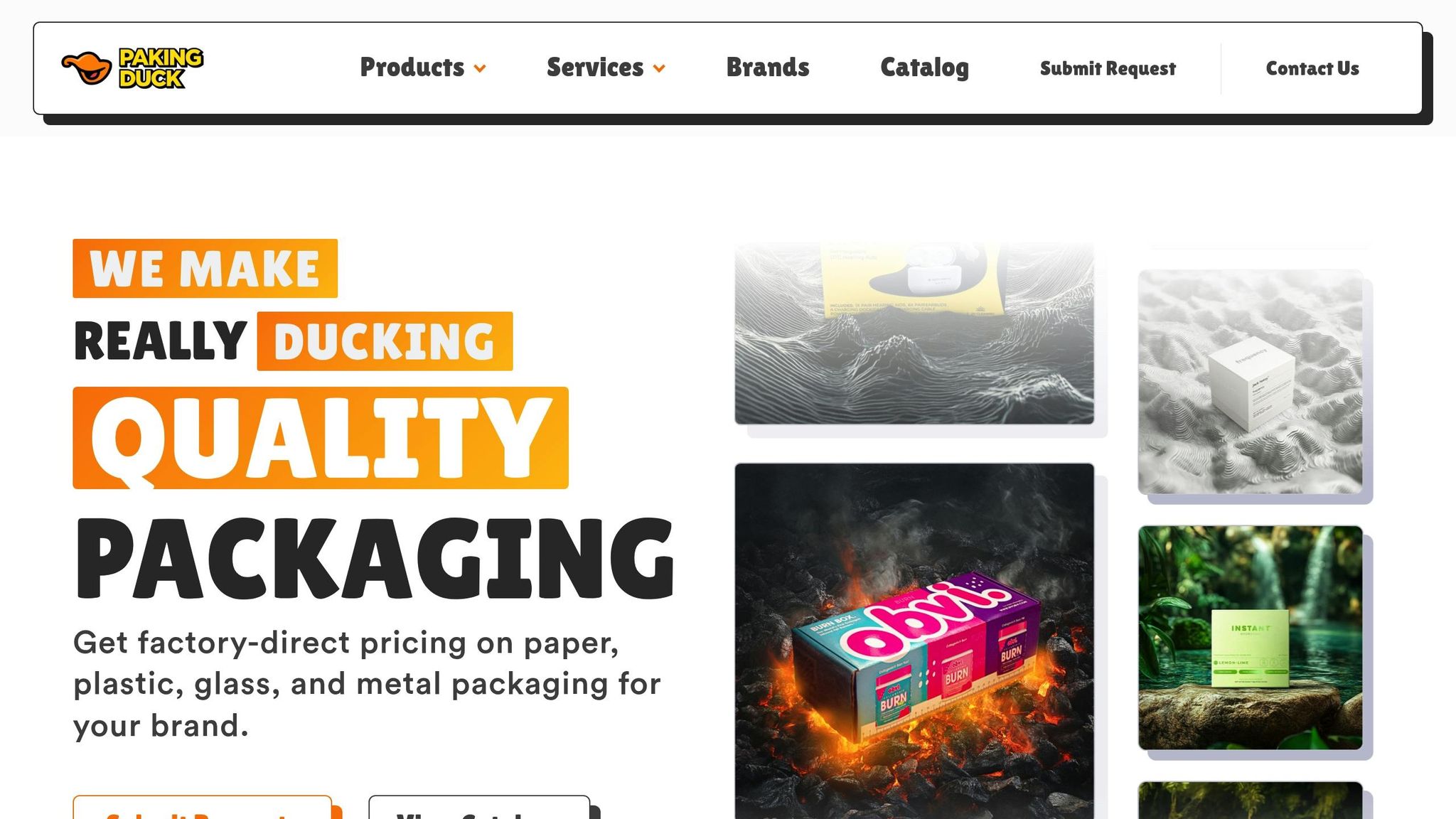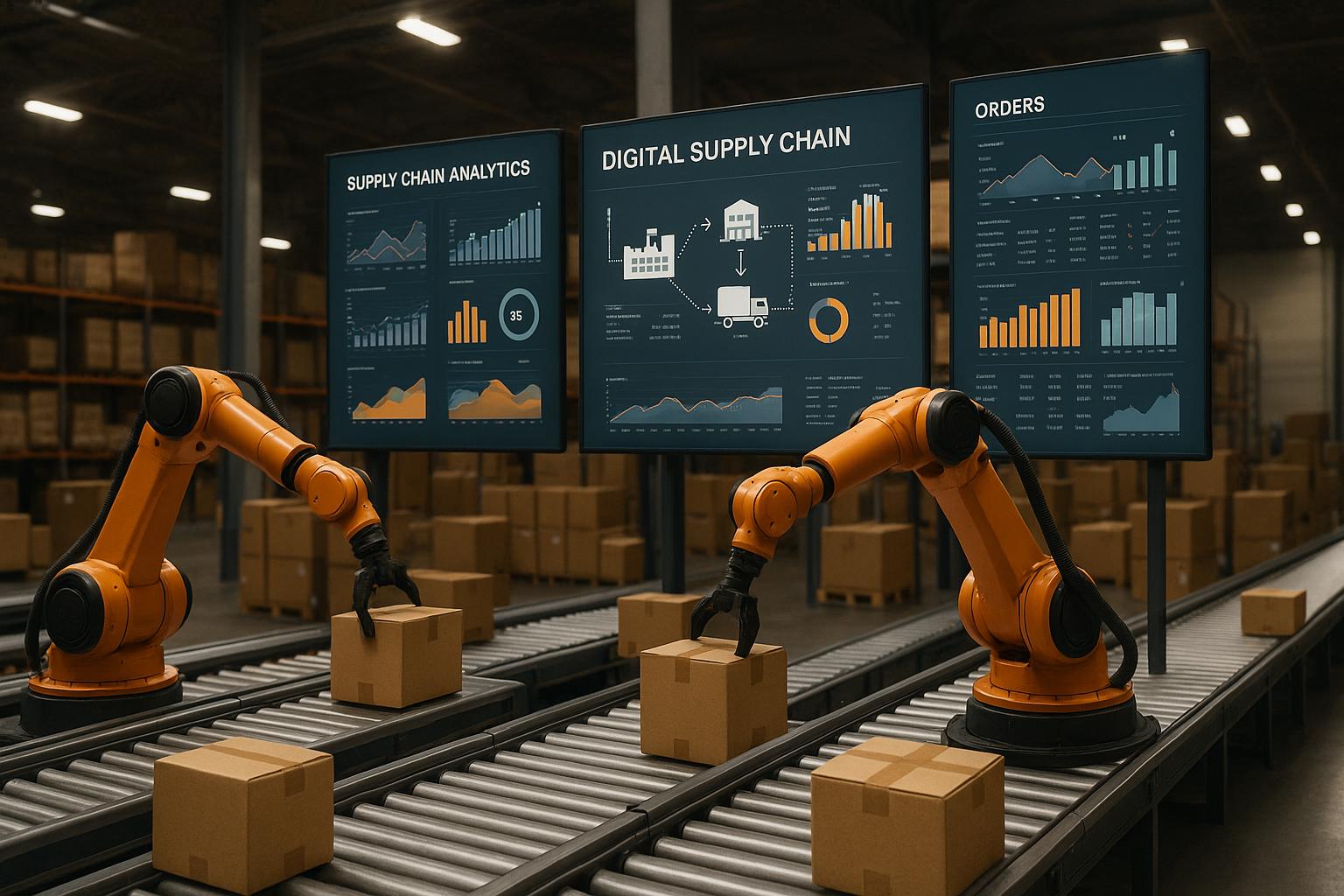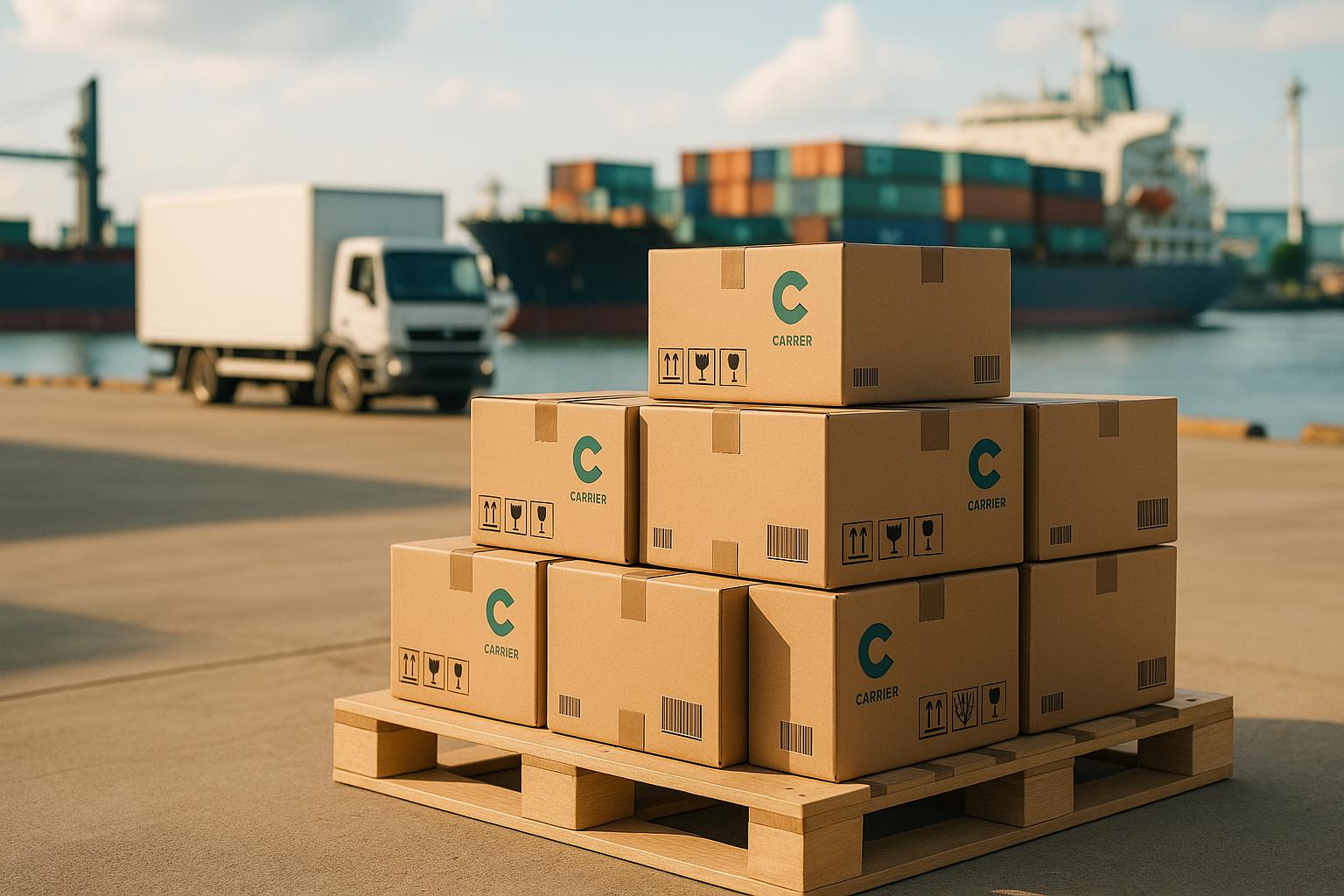Digital supply chains offer CPG brands better control, efficiency, and risk management compared to older manual systems. They leverage technology to provide real-time visibility, reduce errors, and prevent costly disruptions like recalls or delays. Key tools like 3D modeling eliminate design flaws early, while digital watermarking combats counterfeiting. These systems also cut packaging costs by around 20% through streamlined processes.
In contrast, older supply chains rely on manual workflows, which lead to slower issue detection, fragmented oversight, and higher operational costs over time. While they require less initial investment, they lack scalability and flexibility, making them less effective for growing businesses.
Quick Takeaways:
- Digital systems: Real-time tracking, predictive risk management, and lower error rates.
- Manual systems: Simpler setup but prone to delays, errors, and inefficiencies.
- Cost savings: Digital supply chains reduce packaging costs by ~20%.
For CPG brands, investing in digital supply chains ensures smoother operations, stronger brand protection, and better customer experiences.
Digital Supply Chain Design to Consume: Plan
1. Digital Supply Chains
Digital supply chains represent a shift from traditional, manual workflows to technology-powered systems, giving CPG brands greater control and efficiency. By tapping into advanced tools, these systems enhance transparency and adaptability across packaging and logistics networks.
Risk Management
When it comes to managing risks, digital supply chains move the needle from reactive problem-solving to proactive prevention. For example, digital watermarking helps tackle counterfeiting, safeguarding brand reputation. Additionally, integrated platforms streamline vendor management by introducing consistent quality control measures, reducing the likelihood of costly errors.
Real-Time Visibility
One of the standout features of digital supply chains is the ability to monitor every phase of the packaging and delivery process in real time. From sourcing raw materials to the final delivery, this enhanced visibility empowers businesses to make smarter, data-driven decisions.
"Packing Duck provided great service, communication, and visibility throughout the entire process. They were fantastic at setting expectations and keeping everything on track. The quality of the pouches is outstanding, even with digital printing. Plus, the same quantity in the UK would have cost four times as much landed - an unbeatable value!" - Optimiise
Real-time tracking also benefits customers and stakeholders by providing updates on order status, shipping timelines, and delivery estimates. This not only builds trust but also minimizes uncertainties related to delays or service issues.
Technology Integration
Digital supply chains bring together various technologies to streamline operations. For instance, interactive 3D modeling allows brands to visualize packaging designs and pinpoint issues before production begins. This reduces the risk of design flaws and production setbacks. Up next, we’ll explore how traditional supply chains measure up when addressing these challenges.
2. Conventional Supply Chains
Unlike digital systems, traditional supply chains rely heavily on manual processes, paper-based documentation, and basic communication tools. This approach often results in delays and fragmented oversight, creating challenges for brands aiming to maintain efficiency and control.
Risk Management
Traditional supply chains highlight why reducing risks in packaging and operations is crucial for Consumer Packaged Goods (CPG) brands. These systems often lack the ability to detect and address risks early. Problems like quality defects, shipping delays, or supplier failures typically surface only after they've disrupted operations. Risk management in these models depends on periodic audits, manual inspections, and historical data, which leaves little room for proactive action. The result? Longer recovery times and increased costs.
Fragmented documentation further complicates the process, making it harder to track compliance or spot risks early. This disorganization can lead to regulatory penalties or unexpected supply chain disruptions.
Real-Time Visibility
One of the biggest drawbacks of traditional supply chains is the limited visibility into ongoing operations. Updates are often manual and sporadic, leaving brands to make critical decisions - like inventory management or production scheduling - based on outdated information.
Manual tracking methods, which require data entry at multiple checkpoints, are prone to errors and delays in communication. Different departments may hold conflicting data on orders or inventory levels. This disconnect can result in overstocking, stockouts, or missed promotional deadlines, all of which hurt both revenue and customer satisfaction.
Technology Integration
Traditional systems are often built on isolated, outdated software, requiring manual data transfers between platforms. This fragmented setup increases the risk of errors and makes it difficult to maintain consistent information across the organization.
These systems also lack advanced analytics capabilities. Instead of leveraging predictive models or automated alerts, brands are left relying on basic reports and spreadsheets. This makes it harder to spot opportunities for improvement or predict future needs based on market trends.
The manual nature of these systems introduces additional challenges. For example, design changes, specification updates, or quality requirements must be communicated across multiple channels, increasing the likelihood of miscommunication. In the next section, we’ll dive into the pros and cons of these contrasting supply chain approaches.
sbb-itb-e0a0838
Advantages and Disadvantages
Digital and conventional supply chains each come with their own set of strengths and weaknesses, influencing how CPG brands manage operations, control costs, and maintain customer satisfaction. By examining these trade-offs, brands can make smarter decisions about their supply chain strategies, especially when balancing efficiency and cost management.
Digital supply chains shine in areas like predictive analytics and quick problem-solving, but they demand a significant initial investment and a high level of technical expertise. The ability to detect issues early helps prevent costly recalls and delays. However, the complexity of these systems means brands need skilled IT teams and strong cybersecurity protocols to keep everything running smoothly.
On the other hand, conventional supply chains are known for their simplicity and lower upfront costs, making them appealing to smaller brands or businesses with straightforward operations. These systems rely on manual processes that require minimal training and are familiar to most teams. But this simplicity has its downsides: higher operational costs over time, slower issue detection, and limited ability to scale as the business grows.
One of the most noticeable differences between these two approaches is visibility. Digital systems offer continuous monitoring and instant updates across all touchpoints, while traditional methods often rely on outdated or incomplete information. This gap becomes especially critical during peak seasons or unexpected disruptions when quick decision-making is essential. The ability to see the full picture in real time can be the difference between a smooth operation and a missed opportunity.
Here’s a side-by-side comparison of key differences in areas like risk management, visibility, integration, and scalability:
| Aspect | Digital Supply Chains | Conventional Supply Chains |
|---|---|---|
| Risk Management | Predictive analytics, early warnings, automated alerts | Reactive approach, manual audits, historical data analysis |
| Real-Time Visibility | Continuous monitoring, instant updates, centralized dashboards | Periodic updates, manual reporting, fragmented information |
| Technology Integration | Seamless data flow, automated processes, advanced analytics | Isolated systems, manual data transfers, basic reporting |
| Initial Investment | High upfront costs, ongoing maintenance | Lower startup costs, minimal tech requirements |
| Scalability | Easily adaptable, handles growth efficiently | Limited flexibility, manual scaling required |
| Error Rate | Reduced human error, automated validation | Higher error potential, manual data entry |
| Recovery Time | Rapid response, automated corrections | Longer resolution periods, manual intervention |
One of the biggest distinctions lies in resilience. Digital supply chains can reroute shipments, adjust inventory, or switch suppliers automatically based on real-time conditions. In contrast, traditional systems rely heavily on human intervention and manual coordination, which can stretch recovery times from hours to days - or even weeks.
For fast-growing CPG companies, the scalability and efficiency of digital systems often outweigh their higher initial costs. Meanwhile, more established brands may find comfort in the predictability and lower upfront investment of traditional methods, even if it means sacrificing some efficiency and flexibility.
Custom Packaging Solutions and Risk Reduction
Custom packaging plays a critical role in strengthening supply chain resilience and minimizing risks for CPG brands. Unlike one-size-fits-all options, tailored packaging solutions address specific challenges that might disrupt operations, harm brand reputation, or lead to costly product losses during transit or storage.
These solutions don’t just safeguard products - they also improve inventory management, shipping efficiency, and customer satisfaction. By partnering with specialized packaging providers, brands gain access to materials and designs that can handle unique environmental conditions, reduce damage rates, and streamline logistics.
The Role of Materials in Risk Reduction
Selecting the right materials is essential for reducing risks over the long term. For example:
- Paper-based packaging is cost-effective and eco-friendly but might need extra protection for moisture-sensitive items.
- Plastic packaging offers excellent barrier properties and durability, making it suitable for products with long shelf lives or those exposed to harsh shipping conditions.
- Glass and metal containers provide top-tier protection and enhance brand positioning but require careful handling to avoid breakage.
Benefits of Direct Supplier Relationships
Working directly with suppliers simplifies operations by cutting out intermediaries, which improves production timelines, quality control, and inventory management. When disruptions like material shortages or transportation delays arise, brands with direct supplier connections can adapt more quickly and effectively.
Proactive Risk Management Through Expert Consultation
Consulting with packaging experts helps identify vulnerabilities, such as compatibility issues, stress points during shipping, or regulatory compliance risks. This proactive approach prevents costly problems like packaging failures during peak seasons, regulatory penalties, or design flaws that compromise product integrity.
Customization also allows brands to tailor packaging to their specific supply chain needs. For instance, companies shipping to diverse regions can design packaging to withstand varying climates, handling practices, and regulatory standards. Seasonal products can benefit from packaging that performs well across different temperature and humidity levels. This attention to detail reduces the chances of product returns, customer complaints, and emergency repackaging expenses.
Comprehensive Solutions from Paking Duck

Paking Duck showcases how specialized providers can enhance supply chain resilience through a wide range of custom packaging options. Their offerings include standard and corrugated boxes, rigid boxes, shopping and mailer bags, flexible pouches, tin containers, stickers, labels, and tissue paper. These options enable brands to build cohesive packaging strategies that address risks at every touchpoint in the supply chain.
By leveraging Paking Duck’s expertise, brands can avoid common pitfalls like extended lead times, quality issues, and regulatory gaps - challenges that often derail growth plans.
Protecting the Brand and Customer Experience
Custom packaging doesn’t just reduce operational risks; it also protects the brand and ensures a consistent customer experience. Thoughtfully designed packaging preserves product quality throughout the supply chain, ensuring customers receive items in perfect condition, no matter the shipping distance or handling conditions. This reliability helps prevent negative reviews, returns, and damage to brand reputation - factors that can have lasting impacts on market position and customer loyalty.
Conclusion
Digital supply chains are reshaping how CPG companies operate, bringing real-time visibility, increased adaptability, and better risk management compared to older methods. With the ability to monitor products as they move, predict potential disruptions, and respond swiftly, brands leveraging digital tools gain a clear edge in today’s competitive market.
This shift toward digital systems proves especially valuable during unpredictable events like natural disasters, supplier breakdowns, or sudden spikes in demand. These systems provide the resilience needed to navigate such challenges effectively.
For U.S.-based CPG companies ready to make this leap, the best starting point is digitizing critical areas such as inventory tracking, supplier communication, and demand forecasting. These steps not only reduce risks but also deliver quick returns by improving operational transparency almost immediately.
Instead of overhauling everything at once, consider adopting cloud-based platforms that integrate seamlessly with your existing systems. This way, you can avoid major disruptions while laying the groundwork for advanced tools like artificial intelligence and machine learning down the line.
Selecting the right partners is essential during this process. Collaborate with suppliers and service providers who are well-versed in digital supply chain needs and can support real-time data sharing and automation.
The payoff for investing in digital supply chains is clear: lower inventory costs, happier customers, and stronger brand protection. Companies that embrace this transformation will be better equipped to succeed in the fast-paced world of consumer goods, while those that hesitate risk falling behind and losing both market share and customer trust.
FAQs
How do digital supply chains help CPG brands manage risks more effectively than traditional methods?
CPG brands can tackle risks head-on with real-time data and predictive analytics offered by digital supply chains. These tools help anticipate disruptions before they happen, allowing companies to act swiftly to reduce downtime and prevent significant losses.
Traditional supply chains often rely on static, reactive processes, which can leave brands scrambling when unexpected issues arise. In contrast, digital supply chains are interconnected and adaptable, making it easier to respond to changes like shifting demand, supply shortages, or sudden market challenges. This flexibility ensures operations stay on track, even in unpredictable conditions.
Switching to digital systems empowers CPG brands to create supply chains that can handle uncertainty while maintaining steady performance.
What are the upfront costs and key technical needs for adopting a digital supply chain system?
Adopting a digital supply chain system in the U.S. comes with an average upfront cost of $27.5 million. This hefty price tag stems from investments in cutting-edge technologies like artificial intelligence (AI), cloud computing, and cybersecurity. These tools are crucial for streamlining operations and boosting overall efficiency.
To make it work, several technical elements need to come together. These include IoT (Internet of Things) devices for seamless connectivity, AI-driven tools for smarter automation, blockchain technology to ensure secure transactions, and real-time data analytics for faster, more informed decision-making. On top of that, strong cybersecurity measures are a must to protect sensitive digital assets and keep the system secure.
While the upfront costs may seem daunting, the long-term rewards - like better efficiency, reduced risks, and enhanced supply chain visibility - often make the investment worthwhile.
How can CPG brands adopt digital supply chain technologies without disrupting their current operations?
To integrate digital supply chain technologies effectively, CPG brands should take a step-by-step approach and emphasize teamwork. Begin by rolling out tools gradually, ensuring that daily operations remain uninterrupted. Focus on real-time data sharing and improved visibility to make smarter decisions and respond swiftly to changes.
Establishing solid partnerships with supply chain partners and encouraging open communication are equally important for a seamless shift. By approaching digital transformation in manageable stages, brands can reduce risks, boost efficiency, and keep their operations running smoothly.







.svg.png)